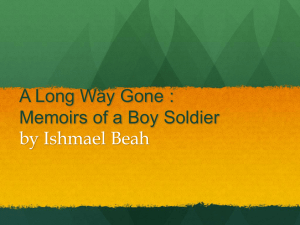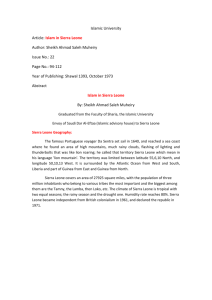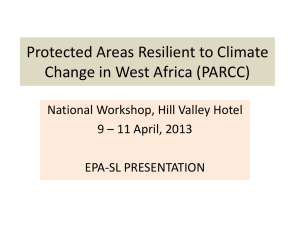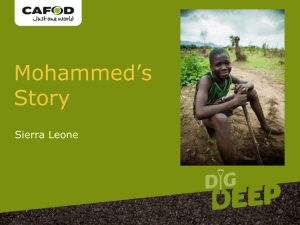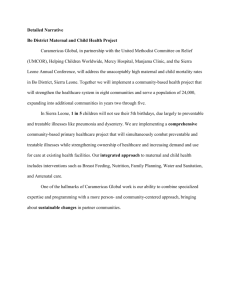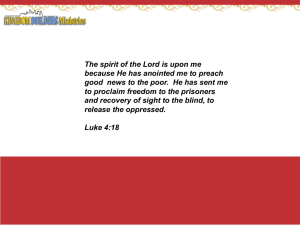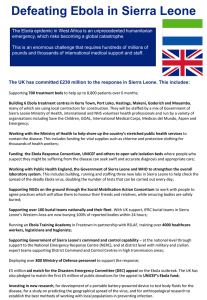1.5 Researching the Civil War in Sierra Leone
advertisement
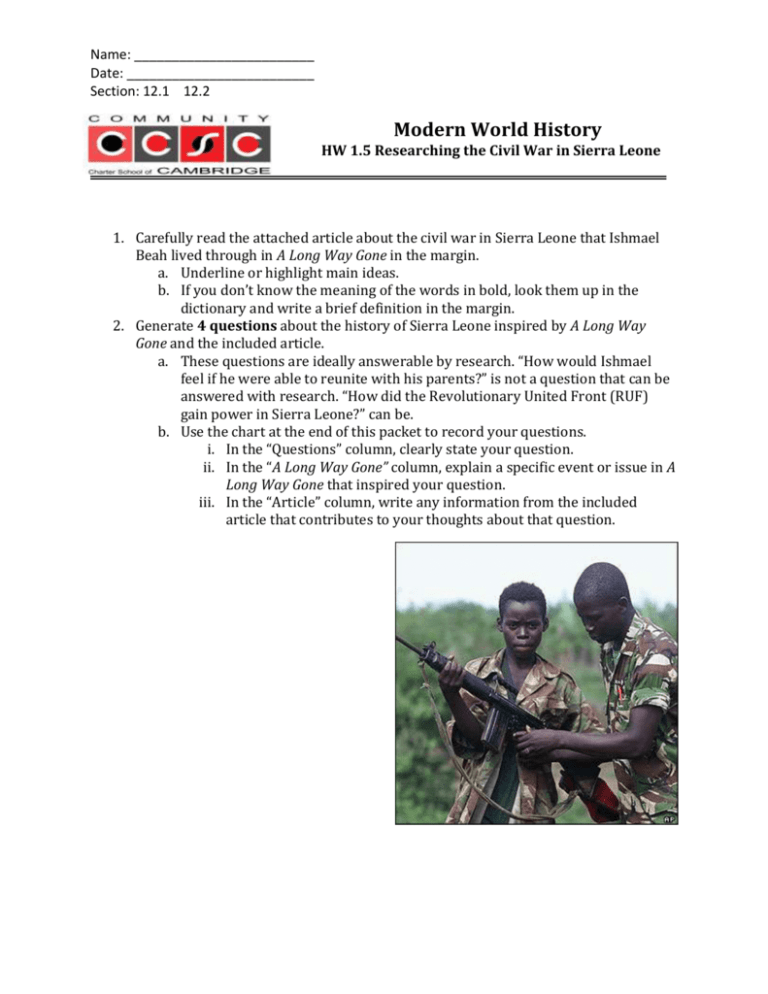
Name: ________________________ Date: _________________________ Section: 12.1 12.2 Modern World History HW 1.5 Researching the Civil War in Sierra Leone 1. Carefully read the attached article about the civil war in Sierra Leone that Ishmael Beah lived through in A Long Way Gone in the margin. a. Underline or highlight main ideas. b. If you don’t know the meaning of the words in bold, look them up in the dictionary and write a brief definition in the margin. 2. Generate 4 questions about the history of Sierra Leone inspired by A Long Way Gone and the included article. a. These questions are ideally answerable by research. “How would Ishmael feel if he were able to reunite with his parents?” is not a question that can be answered with research. “How did the Revolutionary United Front (RUF) gain power in Sierra Leone?” can be. b. Use the chart at the end of this packet to record your questions. i. In the “Questions” column, clearly state your question. ii. In the “A Long Way Gone” column, explain a specific event or issue in A Long Way Gone that inspired your question. iii. In the “Article” column, write any information from the included article that contributes to your thoughts about that question. Background: The Civil War in Sierra Leone Compiled by Afrol.com. Based on IRIN (UN Office for the Coordination of Humanitarian Affairs), Partnership Africa Canada, MSF and Human Rights Watch. There is still a civil war going on in Sierra Leone, in practical terms (note: this article was written in 2000). Since 1991, the country has suffered war, terror and a deep, unrelenting humanitarian crisis which have left it devastated. The war has curbed agricultural production drastically, cut government profits from mining and seen the destruction of hundreds of schools, health clinics, and administrative facilities. Forced displacement has affected more than half the population estimated at 4.5 million. Between 20,000 and 75,000 people have been killed and thousands mutilated. Dislocation of people and destruction of schools have exacerbated the educational crisis in the country, which has a literacy rate of about 20 per cent. The rebel Revolutionary United Front (RUF) led by Foday Sankoh has displayed a staggering capacity for brutality. In May 2000, the RUF overturned a fragile peace process and plunged the country back into war. Sankoh was captured on 17 May 2000, but this has not kept the RUF from continuing their fight and terror actions. It is well documented that the RUF is using terror tactics such as mass rape, torture and mutilation of civilians, abduction of children to become child soldiers or sex slaves and massive intimidation. The worst of it might be that there may be no other motives for this than maintaining control of the rich diamond fields of Sierra Leone. The war in Sierra Leone is being fought more over economic resources than over ideology. Why did a war break out in Sierra Leone? Before the outbreak of war, corruption and mismanagement in the diamond sector was one of the main reasons why Sierra Leone became, according to UN figures, the poorest country in the world. With the breakdown of state structures and the suppression of civilian opposition, wide corridors were opened for trafficking of arms and ammunition and drugs, all of which eroded national/regional security and facilitated crime within the country and between Sierra Leone and Liberia and even Guinea. The brutal civil war going on in neighboring Liberia also played an important role in the outbreak of fighting. Charles Taylor – president of Liberia – reportedly sponsored the RUF as a way to destabilize Sierra Leone. Sierra Leone then was a base for the West African peacekeeping force ECOMOG (Economic Community of West African States Monitoring Group) that was preventing Taylor from seizing the Liberian capital, Monrovia. Taylor reportedly helped make a deal with the government in Burkina Faso on behalf of the RUF for the supply of mercenaries from Burkina Faso with payment to be made in Sierra Leone diamonds, analysts claim. How and when did the war begin? The RUF launched its first campaign into eastern Kailahun (Sierra Leone) from Liberia in March 1991. Sankoh was head of the military wing of the RUF that included in its ranks NPFL 2 members and Burkinabes (people from Burkina Faso). According to Sierra Leonean writer Abdul Koroma, the rebels were quick to demonstrate their brutality, decapitating community leaders and putting their heads on stakes. Oxford University researcher Forced recruitment of children was also an early feature of rebel strategy. The intellectuals in the RUF opposed the methods being used, but within the first year of the rebellion, they had been eliminated in purges as Sankoh took over the movement. What is the RUF? RUF is the Sierra Leonean rebel group Revolutionary United Front (RUF) led by Foday Sankoh. Sierra Leone academics argue that the RUF originally had a legitimate political foundation based on student-led opposition to the repressive and corrupt one-party regime of Siaka Stevens (1968-85). Student radicals and lecturers thrown out of universities in the 1980s after a series of protest actions headed for exile in Ghana. Led by intellectuals such as Abu Kanu and Rashid Mansaray, they travelled on to Libya for military training. Rebel leader Sankoh initially was among those in Sierra Leone that helped recruit would-be revolutionaries. Forthright and charismatic, he reportedly made a strong impression, particularly among the young radicals. In 1990, he travelled to Liberia with the NPFL/RUF and met the Liberian Charles Taylor. Taylor started sponsoring the RUF. Despite its brutal attacks on civilians, RUF claims it is a movement of the downtrodden in opposition to the country's corrupt political class. Sankoh said in a statement in March 2000: "We seized the moment of 1991, at the height of misrule, to face the challenge of countering the nefarious plans that party had hoped to put in place to entrench itself in power." A report this year by Partnership Africa Canada (CAP) into the link between diamond smuggling and the war, stressed that: "Only a fraction of Sierra Leone's young people joined the RUF of their own volition … (The vast majority) were children who were kidnapped, drugged, and forced to commit atrocities." Girls were also kept as sex slaves. Numerous human rights reports document how terror techniques were used to instill allegiance such as forcing abductees to kill their parents and neighbors. Some children were abducted when they were so young, and have fought for so long, they no longer remember where they came from, much less why they are fighting. The only family they know and trust is their rebel unit. In addition, RUF "officers" are themselves former abducted children. Even the senior RUF field commanders are only in their mid-20s. What are government forces doing? Successive governments have recruited from among the same "alienated youth" as the RUF. In 1991, Momoh doubled the size of the army to counter the RUF threat, drawing conscripts from urban ghettoes, but could not supply or pay his men. In 1992, young officers led by Captain Valentine Strasser (26) overthrew him. Some of Strasser's lieutenants were only 21 years old. Discipline further disintegrated in the badly-equipped and poorly trained army, and field commanders began recruiting and arming conscripts, some of them children. The government's inability to defend local communities led in 1993 to the rise of the Kamajor (traditional hunters militia) in the south, who fought on the government's side. The militia also used child soldiers. By 1994, as the countryside collapsed, communities were being attacked by violent youths who were either RUF, or renegade soldiers - the so-called Sobels (soldier-rebels). 3 The country's diamond-producing areas in the south and east were overrun by RUF and soldiers, who were also mining diamonds rather than fighting the rebels. How is the situation for the civilians? The Sierra Leone civilians seem to be the main target of RUF terror actions. RUF fighters have been quoted saying, "Since you civilians are not here for us, we are here to destroy you," according to Human Rights Watch. Terror has been massive, for years, and it is well documented. . Women in RUF-controlled areas are at constant risk of being abducted and raped. RUF further is forcing many children, included RUF child soldiers who earlier had laid down their arms, to join its ranks. Many other children are being abducted by the RUF to carry military equipment and looted goods, and female abductees are regularly raped. The RUF has a long history of using child soldiers, from the first years of armed conflict. Children face some of the gravest abuses in this war at the hands of the RUF," claims Peter Takirambudde, executive director of the Africa Division of Human Rights Watch. "The RUF specifically targets children for recruitment as child soldiers, forced labor, and sexual exploitation." The general humanitarian situation has also worsened during 2000 due to the great number of internally displaced (more than half the population) and lack of food, shelter, basic medicines and sanitation. In July 2000 Doctors Without Borders (MSF) warned of a health crisis in parts of Sierra Leone, especially among the internally displaced. In just two health clinics during the first half of July, MSF monitored a caseload of 9,000 people, indicating the makings of a health crisis. MSF has seen a rise in the number of patients with bloody diarrhea, many of whom are severely dehydrated. Five of the 10 samples tested were diagnosed as Shigella type 1, which is the most contagious form of diarrhea and can lead to epidemics. Malnutrition is also a serious problem. A feeding center run by an international aid organization received 170 severely malnourished and 500 malnourished children during two weeks in July 2000. What is the role of diamonds in the conflict? The UN Security Council on 5 July 2000 decided that "all States shall prohibit the direct or indirect import of rough diamonds from Sierra Leone." Diamond trade from areas occupied by rebel forces, terrorizing civil population, is the main financing source of the civil war – or possibly even the main cause of the civil war, as many analysts say. An estimated 85 percent of diamond production in Sierra Leone is believed to be smuggled out of the country, mainly through Liberia, and has helped fund the RUF's war effort. A report by Partnership Africa Canada points out that other countries that have faced the same social and political problems as Sierra Leone have not degenerated into such levels of violence. "Only the economic opportunity presented by a breakdown in law and order could sustain violence at the levels that have plagued Sierra Leone since 1991," the report notes. "Traditional economics, political science and military history are of little assistance in explaining Sierra Leone's conflict. The point of the war may not actually have been to win it, but to engage in profitable crime under the cover of warfare. Diamonds, in fact, have fueled Sierra Leone's conflict, destabilizing the country for the better part of three decades…robbing an entire generation of children, putting the country dead last on the UNDP Human Development Index." 4 Questions A Long Way Gone Article 5 Questions A Long Way Gone Article 6
